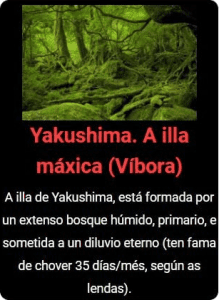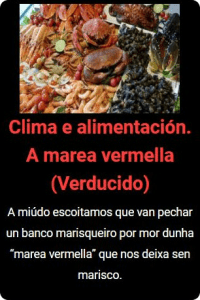
monografías
eltiempoentuojete
Climate and nutrition. The red tide
We often hear from information agencies that are going to close this or that area or shellfish bank because of a “red tide” that forces us to do without our beloved shellfish. So in this article we put on the table that the cause of these “tides” is mainly a meteorological process of the climate of Galicia.
What is its?
Phytoplankton are microscopic organisms that are part of the food of mussels, scallops and other bivalves. They have little capacity for movement and are transported by marine currents. By a natural process of excessive growth (especially of the dinoflagellates) these tides are created, which are neither tides nor always have red coloration. This overgrowth is associated with toxin-producing algae, which cause problems in mollusc farming.
At first sight this increase in algae should benefit the shellfish (and it does). The bad news is that molluscs filter these algae, carry toxins, and can accumulate them over long periods of time.
The toxins
Most of them do not have any problem, but the human consumer can create a clinical picture, which depending on the toxin, may be of different consideration. The three most found in Galicia are:
DSP: Everything outwards. Diarrhea, nausea, vomiting and abdominal pain. They are the most frequent. Symptoms appear within a few hours and remit in three or four days.
PSP: Stiff as a stick. From numbness and itching to paralyzing episodes of breathing.
ASP: I already paid. In this toxin, vomiting, abdominal spasms, disorientation and memory loss stand out.
How does it work in Galicia?
The coastal waters of Galicia, and more specifically, the Atlantic coast, are full of phytoplankton. When the wind blows from the north, or northeast, it pushes the surface waters out of the estuaries, in the direction of the sea. These “voids” that form the wind, are filled with water from the seabed, colder and very rich in nutrients. This makes shellfish species abundant in these waters.
Protective analysis
But as everything has a solution, we have INTECMAR (Technological Institute for the Control of the Marine Environment of Galicia) which continuously analyses the quality of the water (17,000 annual analyses, plus those of producers and purifiers) to determine the presence of the toxin. The quality of the system can make two or more “shellfish fields” remain open or closed within the same estuary.
















